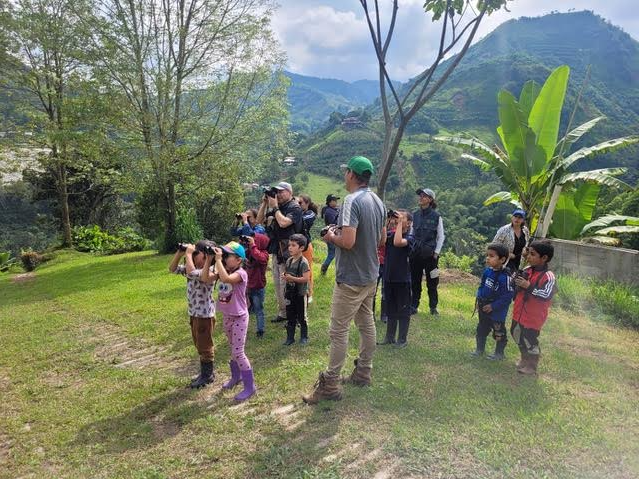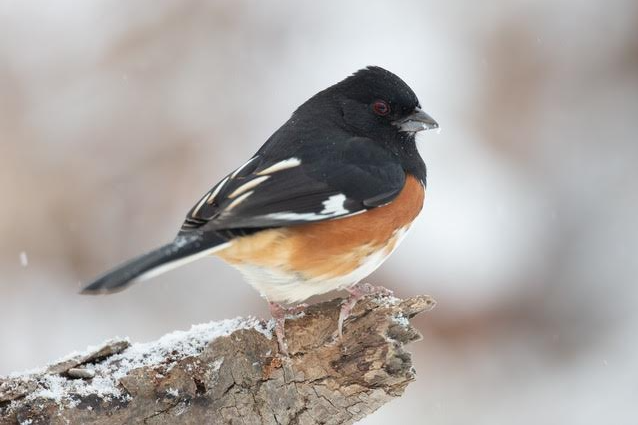Birding for Bucks to Save Birds
By Chandler Roberts, ABAS Birdathon Chair
This year marks the 37th annual Amos Butler Audubon Birdathon, and this year we have received an unprecedented number of grant requests ranging from a variety of research projects to habitat restoration and new forms of outreach. North American birds continue to face big challenges, from climate change to habitat loss, but ABAS works to build on past successes like the wonderfully successful partnership with the American
Bird Conservancy and their work in Central and South America. We also look for new opportunities to both protect birds and help others get excited about birds and the important roles they play in the world. We are thrilled about the grant requests we received this year and all of the great work being done in Central Indiana and beyond. Please help us raise the $38,832 necessary to fund this wide range of 2024 Birdathon projects.
Continuing Reforestation in the Central Andes
American Bird Conservancy: $15,000. In 2023 the American Bird Conservancy far exceeded its goals in producing and planting 40,106 native trees to create migratory corridors in the Central Andes BirdScape of Colombia. It also went beyond its goal to engage 80 farmers to participate in conservation projects by engaging nearly twice that number. With such great results, we will continue to support ABC and its local partner in
Colombia, Vivo Cuenca, to create winter habitat for migratory birds such as Golden-winged, Cerulean, and Canada Warblers. All three of these species, which breed in Indiana, are facing population declines due to habitat loss. This year’s grant will again support a forestry technician’s salary for a full year. This position is crucial to the success of the project, since he engages farmers to sign agreements committing to planting trees on their property. With guidance on selecting species and appropriate methods of planting and caring for trees, the farmers provide much of the labor themselves. It has been a winning formula!
Preserving and Enhancing Local Habitats
• Marian University EcoLab: $1,500 to continue a multiyear, ongoing project using students to plant native trees and perennials in an urban gem. This year the focus is on wetland habitat and plantings in prairie sections that had controlled burns last year.
• Keep Indianapolis Beautiful: $2,000 for planting native perennials in the Grace Tuxedo Heritage Park on the near east side of Indianapolis. This pocket park is undergoing a larger transformation to make the space into a community park with a focus on education, art and native plants. The park will also be directly adjacent to the future Blue Line.
• Richland Bean Blossom Community School Corporation: $657 for the construction and placement on school property of twenty Bluebird nest boxes, five woodpecker nest boxes, ten wren next boxes and ten nesting platforms for species like Gray Catbirds and Mourning Doves.
• Holliday Park Foundation: $500 for the improvement of the previously funded bluebird trail at Holliday Park. Funds will go towards repair and materials for the placement of new boxes throughout Holliday Park to ensure nesting sites for Eastern Bluebirds.
Research
• Purdue University: $1,000 for research to better understand the migration of Eastern Towhees in central Indiana. This is an understudied and declining species. The project will utilize radio transmitters to determine when they leave for their wintering grounds and help understand the effects of sex on migration timing.
• Indiana University Rosvall Lab: $405 for equipment for a research project on the importance of female song in Tree Swallows. Research on female song in birds is severely lacking and this project will help to better understand its function in a single species.
• Indiana University Kokomo: $7,270 for a research project tracking and monitoring the migration of Northern Saw-Whet Owls at Eagle Creek Park. Funding will go towards receivers, antennas and nanotags. This project will also take advantage of the MOTUS towers that are to be installed at Eagle Creek Park and Fort Harrison. The research will improve understanding of the biological and ecological needs of Saw-Whet Owls in urban environments and help with targeted habitat management.
• Indiana University: $500 for tent camping permits for a researcher doing flora inventories of 46 sites throughout the Wabash River corridor in southern Indiana. The study will identify plant distribution trends and prevalence of invasive species with the goal of providing practical conservation strategies at these sites.
• Center for Earth and Environmental Sciences at IU Indianapolis: $4,100 for a year’s worth of monitoring and data collection of bird window strikes on the IU Indianapolis campus. The data will be used to evaluate the timing, prevalence and severity of bird-building collisions on campus, as well as provide information that will guide efforts to make IU Indianapolis a more bird-friendly campus.
Education and Outreach
• Utopia Wildlife Rehabilitators: $2,000 to sponsor a week-long nature-focused summer day camp for youth. The summer camp will host 30 students, aged 8-13. Campers will learn about animal habitats and behavior, urban wildlife, endangered species and conservation as well as careers in wildlife, all while being immersed in native Indiana wildlife for the week.
• Conner Prairie Museum: $2,500 to sponsor the first Black Birders Week event in central Indiana. This pilot program promises a range of events at Conner Prairie that will uplift and highlight Black nature enthusiasts and birders, and help grow a new group of birders. ABAS is very excited about funding this new program and starting a new partnership to increase outreach in Central Indiana.
• Carmel Clay Parks: $1,400 to purchase binoculars that will be used in birding classes and programs for school groups, summer camps, Scouts, and adaptive programs.
Make a Difference, Make a Pledge
Birdathon teams will be scouring the state during May, counting birds and asking donors to sponsor their efforts. If you don’t know a team member, you could choose to make a donation directly to the Birdathon. Either way, your dollars will go far to ensure the future of our Indiana birds.
Donate online at: https://www.amosbutleraudubon.org/birdathon/birdathon-donation/.
Top Photo:The Eastern Towhee is the focus of a Purdue University research project. Photo by Ryan Sanderson.
Bottom Photo:Birdwatching with the local community, children and their families, in Pueblo Hondo, Neira municipality. Photo courtesy of the American Bird Conservancy.


